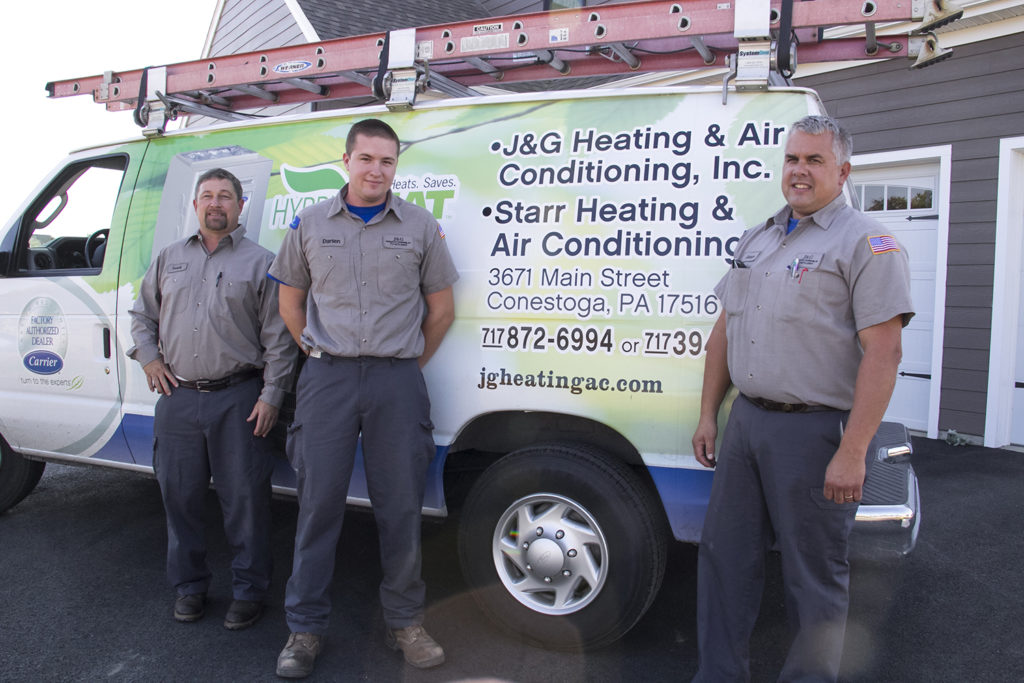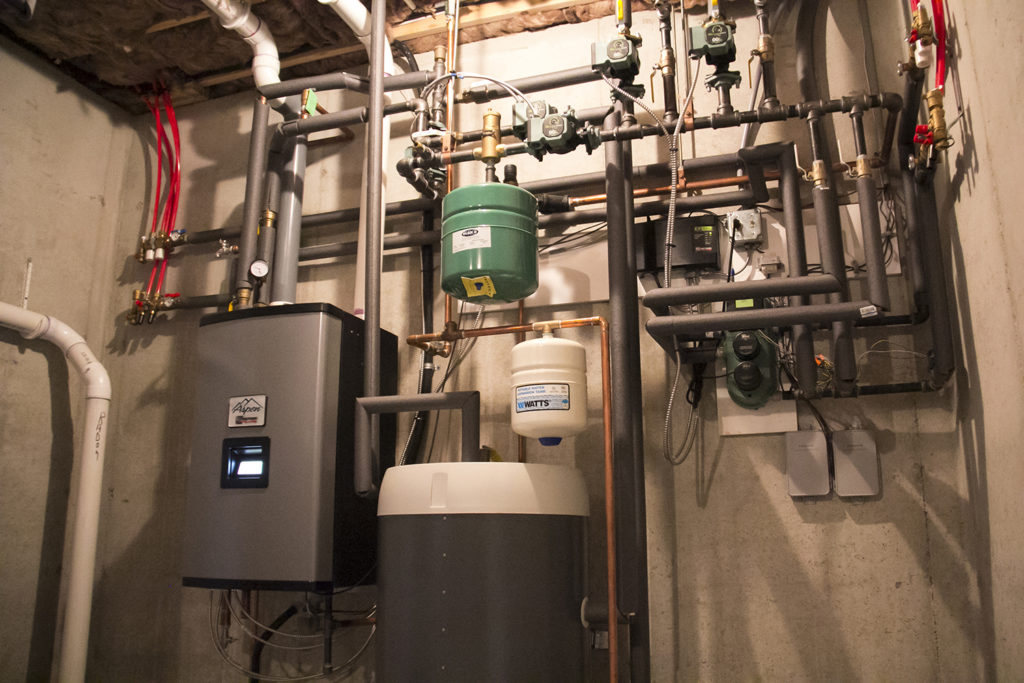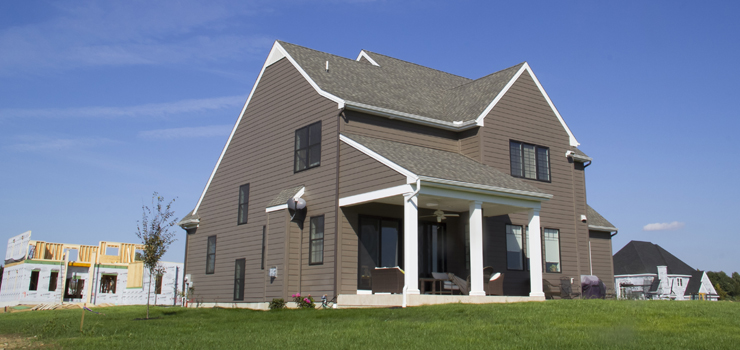Lititz, Pennsylvania, has not seen a strong single-family, new construction market for almost a decade. However, due to recent growth, the economy in the southeastern part of the Keystone State is on the rebound.
With interest rates still low, small business slowly blossoming, and nearby Lancaster City in the midst of a revitalization effort, framing crews are busy again.
Many HVAC contractors are scheduling service and retrofit around construction schedules, and business owners are shouting louder than ever about the scarcity of fresh apprentices and seasoned techs.
With seven trucks on the road, J&G Heating & Air Conditioning is one of the local companies that’s noticed the uptick. The company was founded in 1999 by Jason Sweigart and Gary Ream.

Above (L-R): J&G Service Manager Justin Ream, Installation Technician Shaun Goshert, and the company’s co-founder, Jason Sweigart outside the new home in Lititz.
Not long ago, a return customer brought plans to J&G for their new home, soon to be built less than a mile from their previous residence.
“They were moving from one side of the golf course to the other, looking to get into a brand new home,” said Sweigart. “As far as the mechanical system was concerned, the family had two requests; all systems needed to be high-efficiency, and there would be no compromise on comfort.”
Just south of Lititz is one of the state’s premier country clubs, Bent Creek. It made local news when superstar Lady Gaga was sighted there shopping for a home. She ended up not purchasing a property, but the course still draws players from around the country and is home to the country’s longest-running annual golf tournament.
The countryside north of the club was largely undeveloped until recently. Now, excavators and general contractors are bustling to maintain deadlines at a new development.
J&G’s involvement began in April, roughing in ductwork and assembling a material list for the hybrid forced-air and hydronic system in the two-story, 3,400-square-footcustom home.
Hydro air
Two, three-ton, 19-SEER condensing units are used to provide air conditioning to the home’s two ducted zones. Each of the air handlers – one upstairs and one down – also include a hot water coil to supply all heating to the home.
In areas where high-efficiency, variable-speed air conditioners qualify for utility incentives, using a hybrid system instead of a heat pump allows the homeowner to capitalize on air conditioning rebates. And that’s without mentioning any rebates available for hydronic components and condensing boilers, like the U.S. Boiler Aspen high efficiency condensing boiler that J&G installed.
Justin Ream, Service Manager and Installation Technician, and Shaun Goshert installed the 155 MBH Aspen firetube boiler. The unit supplies all heat for the home, largely through the two 72,000 BTU hydronic coils. The Aspen boiler offers up to 96% AFUE, comes in five sizes, provides a 10:1 turndown ratio, and is available as a 155 MBH combi. One advantage of firetube heat exchangers is their significantly lower pressure drop when compared to watertube models of the same capacity.

Above: The new home’s hybrid HVAC system includes an Aspen high efficiency condensing boiler, a Sage Zone Control, ECM circulators, hydronic air handlers, and high-SEER air conditioning units.
“When you’re sizing hot water coils, you do so by specifying the physical dimensions of the top of the air handler,” said Sweigart. In reality, the coils are oversized for the home. That allows the installer to use a slightly lower water temperature while being careful not to go so low that heat transfer to the air stream becomes insufficient.
The boiler also supplies hot water to a 40-gallon indirect water heater. While forced air provides primary heat to the home, a supplementary in-floor radiant system is used in certain areas to provide premium comfort.
Taking the edge off
“The homeowners regretted not putting radiant heat in the floor of the spare room above the garage in their last home,” said Sweigart. “Despite having carpet on the floor and ample ductwork, that room always had a chilly floor because it was above unconditioned space. They wanted to avoid that this time.”
Before drywall was hung in the garage, technicians installed five-eighths-inch Zurn PEX and aluminum heat transfer plates in the joist bays. R-30 bat insulation is used below the oxygen-barrier PEX. The room above is the daughter’s bedroom. At this house, she’ll be comfortable even if she’s not wearing socks.
The home also has a few other radiant circuits. The Jack-and-Jill bathroom and master bath upstairs are heated from below the tile, as is the mudroom downstairs. In all, there are five heating zones in the house circulated with Taco 007e pumps and Zone Sentry zone valves.
The two hydro-air zones need water between 160°F and 180°F, depending on outdoor conditions. So J&G used a Radiant Mixing Block to temper down the radiant supply temperature to no more than 110°F in the tile areas, and 120°F in the carpeted bedroom.
Effective and efficient
The overall heating and cooling system design points to premium comfort, but that was only half the equation. The homeowners were adamant that the entire home be just as efficient as it is comfortable, and they started with the building envelope.
The two-by-six frame was heavily insulated, including the garage. The home is situated to capitalize on winter solar gain. To limit the cooling load during summer months the large, south-facing windows have solar shades. LED lighting systems were also used which not only reduces the use of energy to light the home, but limits heat gain.
Sweigart maintained the same attention to energy efficiency when selecting components of the hydronic system.
No matter which zone is calling – or what combination of zones – the Aspen boiler “knows” the exact BTU input needed, thanks to U.S. Boiler’s Sage Zone Control circulator panel.
With simple plug-and-play installation, the zone control corresponds with the boiler control and outdoor reset to calculate zone demand, automatically adjusting the boiler’s firing rate. This saves fuel and reduces short-cycling of a boiler that’s already designed to reduce energy consumption.
To top it all off, web-enabled Honeywell and Carrier T-stats were used. The homeowners wanted to be able to control the indoor climate from their phones. The thermostats also provide humidity control for improved four-season comfort.
“This job serves to showcase the flexibility of using a boiler in a new home,” said Sweigart. “We’re providing radiant heat, forced hot air, and unlimited amounts of domestic hot water. And it’s all being done efficiently, with system longevity in mind.”
J&G completed their portion of the project before deadline. And with work in the Lititz area picking up, time to spare is a good thing.

